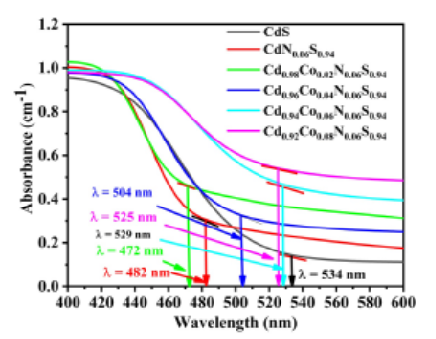


Indian Journal of Science and Technology
Year: 2023, Volume: 16, Issue: 27, Pages: 2024-2034
Original Article
M Surya Sekhar Reddy1,2*, C Sai Vandana3, Y B Kishore Kumar4
1Department of Physics, JNTUA, Ananthapuramu, A.P, India
2Department of Physics, SVCR Government Degree College, Palamaner, A.P, India
3Department of Physics, Government Degree College for Women, Srikalahasti, A.P., India
4Department of Physics, Sree Vidyanikethan Engineering College, Tirupathi, A.P, India
*Corresponding Author
Email: [email protected]
Received Date:28 March 2023, Accepted Date:20 June 2023, Published Date:11 July 2023
Objectives: The purpose of this study is to report the changes in structural, electrical, optical, and magnetic properties of N: CdS nanoparticles with Co2+doping, which have applications in the fields of opto-magnetic and spintronic devices. Methods: Nitrogen and cobalt-co-doped CdS nanoparticles (NPs) have been prepared using the surfactant-assisted chemical co-precipitate method. Findings: The X-Ray Diffraction (XRD) studies with X’pert High Score Plus software confirm the existence of multiphase and the size of the as prepared particles in the nanorange (1-2 nm). UV-VIS. absorption spectral analysis showed a considerable blue shift with the inclusion of nitrogen and a further Burstein-mass effect, i.e., a red shift with increasing Co2+ion concentration. The strong green light emissions observed in photoluminescence (PL) studies are attributed to the trapping of Co2+ and N3-ions in F-centers. The characteristic g = 1.995 obtained from electron paramagnetic resonance (EPR) studies confirms the inclusion of nitrogen in the tetrahedral sites of the CdS core and the increased stability of nanoparticles. The vibrating sample magnetometer (VSM) studies revealed novel magnetic behaviour of nanoparticles at low fields. Novelty: Tunable band gap variations, ferromagnetic nature at low fields are the unique features observed in NPs with useful applications in the fields of opto-magnetic and spintronic applications. Nitrogen and cobalt-co-doped CdS nanoparticles (NPs) have been prepared using the surfactant assisted chemical co-precipitate method. The X-ray diffraction (XRD) studies with X’pert high score plus software confirm the existence of multiple phases and the size of the as prepared particles in the nanorange (1-2nm). UV-VIS absorption spectral analysis showed a considerable blue shift with the inclusion of nitrogen and a further Burstein-mass effect, i.e., a red shift with increasing Co2+ion concentration. The strong green light emission observed in photoluminescence (PL) studies is attributed to the trapping of Co2+, N3-ions in F-centers. The characteristic g = 1.995 obtained from electron paramagnetic resonance (EPR) studies confirms the inclusion of nitrogen in the tetrahedral sites of the CdS core and the increased stability of nanoparticles. The vibrating sample magnetometer (VSM) studies revealed novel magnetic behaviour of nanoparticles at low fields.Tunable band gap variations, ferromagnetic nature at low fields are the unique features observed in NPs with useful applications in the fields of opto-magnetic and spintronic applications.
Keywords: Cds; Cobalt; Nitrogen; UV-Vis; EPR; VSM
© 2023 Reddy et al. This is an open-access article distributed under the terms of the Creative Commons Attribution License, which permits unrestricted use, distribution, and reproduction in any medium, provided the original author and source are credited. Published By Indian Society for Education and Environment (iSee)
Subscribe now for latest articles and news.